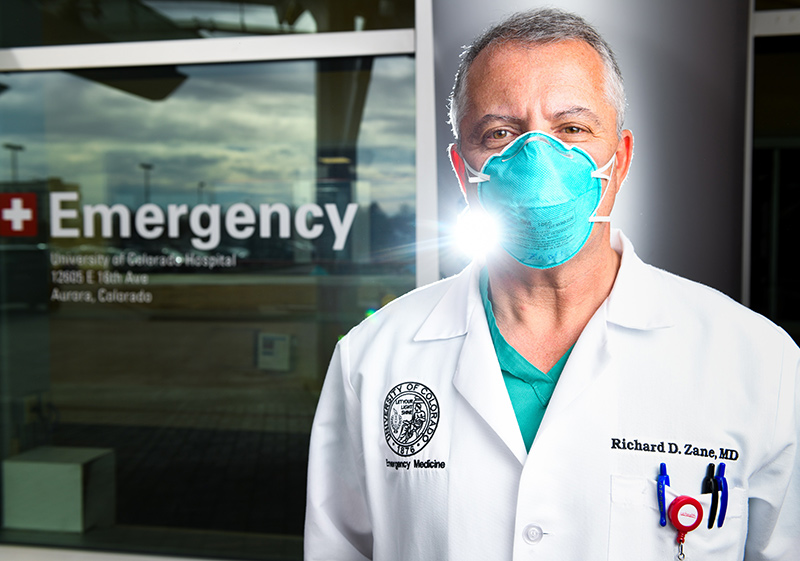
14 Nov UCHealth: Colorado Covid Spite Alarming!
The facts documented in the following article titled “Virus far more dangerous now as Colorado COVID-19 spike sets alarming records” are, at best, sobering. The in-depth story was written by Katie Kerwin McCrimmon from UCHealth Today. In short, wear a mask, wash your hands and social distance or caveat emptor.
Did you know for example that up to half of people who test positive for COVID-19 have no symptoms? That the percent of people who are testing positive for COVID-19 now hovers close to 13%, a dramatic increase from just over 2% in early September and young adults are winding up in hospitals more than ever? Also that the virus seems to thrive in cool, dry air – the weather right now – and social gatherings are spreading it?

Dr. Richard Zane is calling on people to halt social gatherings as the fall Colorado COVID-19 spike sends a record number of COVID-19 patients to hospitals. Here, Zane stands outside the Emergency Department at UCHealth University of Colorado Hospital. Photo by Cyrus McCrimmon for UCHealth.
Colorado is shattering daily records for COVID-19 infections while hospitalizations have soared to the highest levels since the worst peaks of the pandemic, prompting stern pleas from Colorado’s governor and medical experts urging people to wear masks and sharply limit social interactions.
Gov. Jared Polis stopped just short of issuing stay-at-home orders, but called on Coloradans to “save the life of a stranger” and immediately halt all in-person social gatherings with people outside of their homes during the month of November.
Several Colorado counties also are limiting public activities. Denver and nearby counties have imposed curfews, and if the fall spike in COVID-19 cases in Colorado continues to worsen, lockdowns and closures of non-essential businesses could follow.
The startling truth is that the virus that causes COVID-19 is so widespread throughout Colorado that it’s much easier to get infected now, and in turn, to spread the virus to others. Up to half of people who test positive for COVID-19 have no symptoms.
“The virus is far more dangerous now than in the summer. People are exhausted so they’re hanging out with neighbors and friends,” said Dr. Richard Zane, executive director of emergency services at UCHeath University of Colorado Hospital, and UCHealth’s Chief Innovation Officer.
The virus is far more dangerous now than in the summer. People are exhausted so they’re hanging out with neighbors and friends,” said Dr. Richard Zane, executive director of emergency services at UCHeath University of Colorado Hospital, and UCHealth’s Chief Innovation Officer.
Zane echoed Polis’ call to sacrifice now in order to save lives in the coming weeks and months.
“We are seeing people of all ages who are coming in critically ill,” Zane said. “People are so tired of the pandemic. I absolutely commiserate with them, but if the social gatherings continue, they are going to kill someone and people don’t want to do that. If we can just rein it in, we can save lives.”
Zane urged people to focus intently on the safety measures that we all know and understand by now.
“The basic blocking and tackling works. Mask-wearing, hand washing and social distancing help reduce cases,” said Zane who is also a professor and chair of Emergency Medicine at the University of Colorado School of Medicine on the Anschutz Medical Campus.
Why did the fall Colorado COVID-19 spike get so serious so quickly?
So, why have infections risen so quickly this fall? Simple. The virus is acting as viruses do. They’re opportunistic and spread easily from host to host, in this case person to person.
“It’s just math. It’s not personal or cultural. It’s pure and simple math,” Zane said. “It’s very different than it was in July.”
State officials now estimate that about 1 out of every 100 people in the Denver area now has COVID-19. That’s a larger ratio than just a few days ago when the estimate was about 1 in 145 people.
“It’s pure probability. As the prevalence of infections in the community goes up, and people spend more time with one another, exposures go up,” Zane said.
Across the U.S. now, more than 10.1 million people have contracted COVID-19. In Colorado, more than 3,000 people are testing positive for the virus each day, the highest number of infections ever recorded during the pandemic and up from just over 100 cases per day at the low point in Colorado in June.
The number of people who are hospitalized in Colorado with COVID-19 also has spiked, jumping from low points of just over 200 at all Colorado hospitals in early September to nearly 1,200 people now. At UCHealth’s 12 hospitals, the number of patients with confirmed or suspected COVID-19 infections has shot up from a low of 33 in September to 262 as of Nov. 10…
Read on for more. Learn about the rapidly increasing infection rate, how the virus appears to spread better in cold, dry environments, that about 15-to-20% of people with COVID-19 who need hospital care at UCHealth and elsewhere around the state now are people ages 20 to 39, and the sad truth about rapid tests.


Sorry, the comment form is closed at this time.